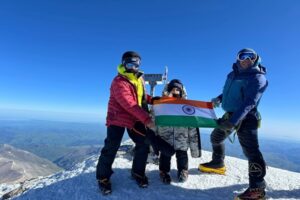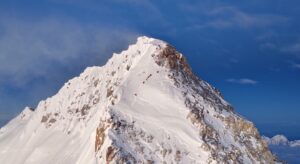For nearly a decade, Everest has stood virtually deserted at this time of the year. Conditions are harder in this post-monsoon season, and logistical difficulties have persuaded the big guided expeditions to target the “easier” 8000’ers. Chinese authorities now impose restrictions on the once-popular Cho Oyu and Shishapangma, so Manaslu has emerged as the preferred peak.
While crowds seem to be Everest’s main nuisance in spring, the problem is precisely the opposite in the autumn: There is almost no one to share rope-fixing and trail-breaking, so the climb becomes a titanic effort — much more like Everest in the olden days.
Difficulties increase on the south side, since the Ice Doctors who open and maintain the route through the Khumbu Icefall every spring are absent. When Alex Txikon attempted the feat in winter 2017, he personally hired three Ice Doctors and brought no less than 80 ladders to Base Camp. Too expensive and difficult for most commercial clients, who are there to climb, not tote.
The option is to attempt Everest from the Tibetan side. Post-monsoon, however, the mountain is usually overloaded with snow and fully exposed to the first winds of winter.
This season, though, a revival of sorts has occurred. At least two teams will bring the mountain to life again with some first-rate action.
As previously reported by ExplorersWeb, Andrzej Bargiel will try to follow up last year’s feat on K2. He will climb Everest without supplementary O2 and on skis from Base Camp to the summit and then back down to BC, including through the Icefall! Bargiel will share Base Camp with Marcin Kaczkan and his large Polish team, which will climb Lhotse in preparation for winter K2 next year. Team member Rafal Fronia will also attempt Everest without bottled oxygen.

The Polish team. Photo: Chhang Dawa Sherpa/Seven Summit Treks
Madison Mountaineering has also confirmed a group of climbers on Everest this fall. Their Sherpa team is already setting up Base Camp and fixing the Khumbu Icefall. Meanwhile, The Himalayan Times broke news of Kilian Jornet’s comeback. THT reports that Jornet will spearhead a three-member team up Lhotse, then move on to Everest. However, Jornet’s press team remains tight-lipped and only confirmed to ExplorersWeb that he is in Nepal “enjoying holidays with his family … In case he completes some significant activity, he will only report it once it is finished,” they said.

The elegant Manaslu. Photo: Seven Summit Treks
Called the Mountain of the Spirit, Manaslu is a highly aesthetic peak which — appearances to the contrary — is straightforward as long as the route is fixed and its avalanche paths traversed with the utmost caution.
For Nirmal Purja, Manaslu will mark number 12 on his remarkable quest to climb all 8000’ers in a single year. Purja is already in Nepal, and we expect that he will keep up his fast, efficient style and get up and down the mountain quickly. By the way, Andorran social-media presence Stefi Troguet has suggested that she’d be happy to join his Elite Himalaya team again: The pair succeeded together on Nanga Parbat in July.
However, Purja’s last two peaks may be hardest of all. According to Alan Arnette, China may close Cho Oyu on October 1 and reject all permits for Shishapangma this year. Will bureaucracy foil what altitude, avalanche conditions and deep snow have not?

Nirmal Purja, centre, and his Sherpa team. Photo: Project Possible
Finally, Carlos Soria has made it back for his eleventh attempt on Dhaulagiri. Soria, now 80, will acclimatize in the Khumbu Valley, in order to spend less time on Dhaulagiri itself. Once acclimatized, he’ll set Camps 1 and 2 in a single go, then make his summit push.

Carlos Soria in Kathmandu. Photo: yoSuboConCarlosSoria




